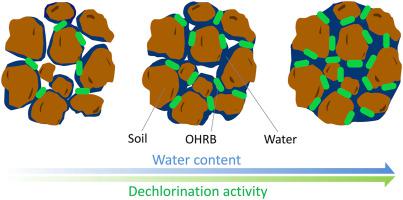Chemosphere ( IF 8.1 ) Pub Date : 2020-12-01 , DOI: 10.1016/j.chemosphere.2020.129152 Rui Shen , Ling Yu , Pan Xu , Zhiwei Liang , Qihong Lu , Dawei Liang , Zhili He , Shanquan Wang

|
Organohalide-respiring bacteria (OHRB) remove halogens from a variety of organohalides, which have been utilized for in situ remediation of different contaminated sites, e.g., groundwater, sediment and soil. Nonetheless, dehalogenation activities of OHRB and consequent remediation efficiencies can be synergistically affected by water content, soil type and inoculated/indigenous OHRB, which need to be disentangled to identify the key driving parameter and to elucidate the underlying mechanism. In this study, we investigated the impacts of water content (0–100%), soil type (laterite, brown soil and black soil) and inoculated OHRB (Dehalococcoides mccartyi CG1 and a river sediment culture) on reductive dechlorination of perchloroethene (PCE) and polychlorinated biphenyls (PCBs), as well as on associated microbial communities. Results suggested that the water content as a primary rate-limiting parameter governed dechlorination activities in environmental matrices, particularly in the soil, possibly through mediation of cell-to-organohalide mobility of OHRB. By contrast, interestingly, organohalide-dechlorinating microbial communities were predominantly clustered based on soil types, rather than water contents or inoculated OHRB. This study provided knowledge on the impacts of major parameters on OHRB-mediated reductive dechlorination in groundwater, sediment and soil for future optimization of in situ bioremediation of organohalides.
中文翻译:

水分作为主要参数决定土壤中微生物的还原脱氯活性
吸入有机卤化物的细菌(OHRB)从各种有机卤化物中除去卤素,这些卤化物已用于原位修复不同的污染场所,例如地下水,沉积物和土壤。但是,OHRB的脱卤活性和随之而来的修复效率会受到水含量,土壤类型和接种的/土著的OHRB的协同影响,需要对其进行分解以确定关键的驱动参数并阐明其潜在机理。在这项研究中,我们调查了水分含量(0–100%),土壤类型(红土,棕壤和黑土)和接种OHRB(Dehalococcoidesides mccartyi)的影响。CG1和河流沉积物培养)对全氯乙烯(PCE)和多氯联苯(PCBs)以及相关微生物群落的还原脱氯作用。结果表明,水分是主要的限速参数,它可能是通过介导OHRB从细胞到有机卤化物的迁移来控制环境基质(尤其是土壤)中的脱氯活性。相比之下,有趣的是,有机卤化物脱氯微生物群落主要基于土壤类型而不是水含量或接种的OHRB进行聚类。这项研究提供了有关主要参数对地下水,沉积物和土壤中OHRB介导的还原性脱氯的影响的知识,以便将来对有机卤化物的原位生物修复进行优化。











































 京公网安备 11010802027423号
京公网安备 11010802027423号